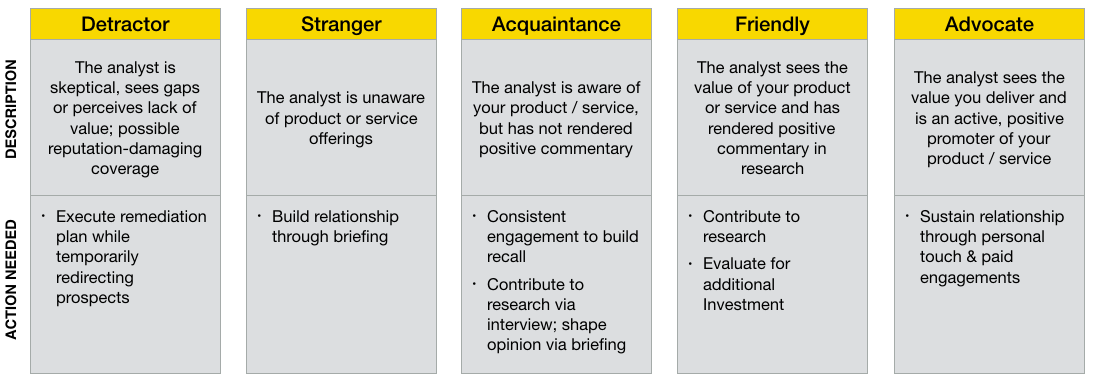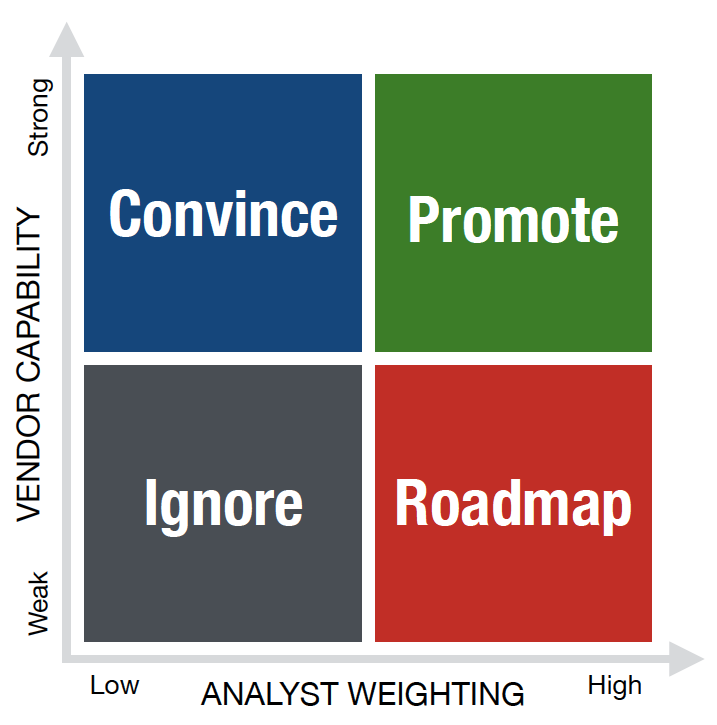When it comes to analyst prioritization and segmentation, there are many ways to divvy up the landscape. Some models we love are organizing analysts by core and opportunistic to our objectives, tiering by levels of engagement, or our personal favorite – the Spotlight Way Maturity Model.
Recent Posts
What's your relationship status? An overview of Spotlight's Maturity Model
Topics: Best Practices, Strategic Planning
The five things you should always note after an analyst interaction
We all know building relationships with analysts doesn’t happen overnight. But, it’s important to remember that it also doesn’t happen without thoughtful and purposeful actions. While it’s a common best practice to prepare before analyst interactions, we believe it’s equally as important to debrief after them. The feedback and nuggets of insight we learn from analysts during interactions like inquiries can help us make momentum towards our ultimate goal with the analyst – if we disseminate and distribute the insights accordingly.
Topics: Best Practices
Four components for keeping your analyst inquiry foundation strong
Whenever you started in analyst relations, inquiries were likely one of the first offerings you heard about from analyst firms. Included in most firm subscriptions, analyst inquiries are uninterrupted time to ask an industry expert about questions specific to your business. But making the most out of analyst inquiries requires us to take a step back and hone in on the foundations of this offered service.
Topics: Best Practices
5 tips for addressing those who think analysts “just don’t get it”
We all have probably experienced our spokespeople returning from an analyst interaction saying, “the analyst just doesn’t get it.”
Topics: Best Practices, Speaker Prep
The best way to create like-mindedness with analysts
Tell me if this sounds like something you’ve dealt with – you and your team feel something about your platform or services is more important than an analyst does.
A Forrester Wave or Magic Quadrant just published. You sigh in relief and pat yourself on the back for another job accomplished. But if you’re like us, it’s not too long before the question starts to creep in – how do we do better next year?
Topics: Strategic Planning, Analyst Perceptions, Magic Quadrants, Waves, etc.
“On a scale of 1-10, how likely is it that you would recommend [brand] to a friend or colleague?”
Ah, the Net Promoter Score question. While this evaluation question itself is remarkably simple, the factors that impact how a recipient answers are complex. What does it actually take to make someone want to recommend you? If we think about this in terms of analyst maturity, what does it actually take to make an analyst be your advocate?
Topics: Best Practices, Analyst Perceptions
Four ways to discover where you stand with analysts
Uncovering an analyst’s perception of your business can feel a bit like searching for hidden treasure. You know their real beliefs are there, but they may not be obvious to you. Your executives and product team look to you to help translate the state of your analyst relationships. Do you have active advocates in the analyst community? Are some skeptics? Do you know?
Topics: Best Practices, Analyst Perceptions
Have the answers to your speakers’ questions, before they even ask them
“Why am I talking to this analyst?”
How many times have you received this question from one of your speakers? Or maybe it was this question, right before the call started: “Oh yeah, Joe Analyst, I remember him. What did I talk about with him last time?”
Topics: Best Practices, Strategic Planning, Speaker Prep
How to determine what analysts actually perceive of you
Consider this scenario: While prepping your executive team for a Wave briefing, your CEO asks, "Where exactly do we stand with this analyst? It seems like she's skeptical of our strategy.”
Topics: Best Practices, Strategic Planning, Analyst Perceptions











